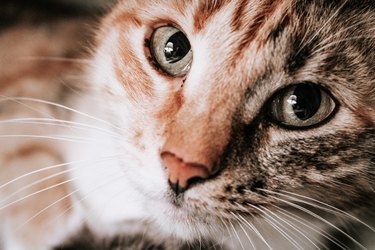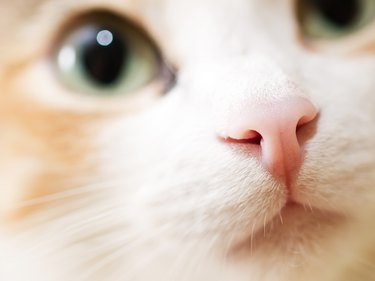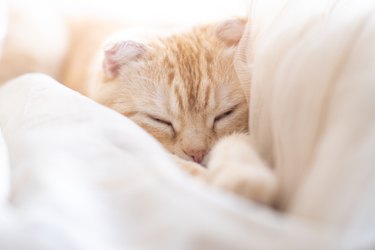Treating a cat nose injury can be a bit complicated due to the tendency of cats to lick, causing the cut on the cat nose to split open again. Whether your cat scratched their nose by sniffing around where they shouldn't or they got scratched in a fight, prompt treatment helps to prevent infection and more serious problems down the road. Large and deep cuts may need veterinary attention, but you can often treat small cuts or scrapes on your cat's nose with a first-aid kit at home. Treat the wound quickly to help it heal properly.

Video of the Day
How do I treat a cat scratch on my cat's nose?
Cats often use their claws when roughhousing with each other or during a cat fight. If you notice your cat has a scratch on their nose from one of their feline companions or after coming back from being outside, you'll need to do a few things:
Video of the Day
- If the wound looks deep, it will likely need stitches. Take your pet to their veterinarian.
- If the cut is bleeding, apply gentle pressure if your cat will let you.
- If the cut is not bleeding, follow the instructions below on how to clean your cat's cut.
- Since scratches from a cat can transmit a bacterial infection called cat scratch disease or cat scratch fever, you'll need to closely monitor the area for two weeks for signs of redness, swelling, or discharge. If your cat develops any of these symptoms or if your cat develops lethargy, a fever, or decreased appetite, contact your veterinarian right away.
Treat the cat nose injury
There are a few steps involved in treating your cat's nose injury. Gather all of your supplies before trying to treat your cat. You'll need a towel or blanket; gauze or a clean, dry cloth; a bowl full of warm, soapy water; and Vaseline or shea butter.
Avoid using triple antibiotic ointment. Cats like to lick things off their nose, and one of the ingredients in Neosporin is Polymyxin B. In rare instances, this ingredient has caused anaphylactic reactions and death in cats.

Restrain the cat
Before you can treat a cat nose injury, you need to restrain your feline friend to ensure uninterrupted access to the wound. Some cats will calmly allow you to administer first aid, but others may lash out or struggle to get away, especially if they are in pain or scared from the event that caused the injury.
- Move slowly and speak quietly to reassure your pet.
- Once you catch them, a safe way to restrain your cat is by wrapping them like a burrito in a bath towel or blanket. This can be reassuring for your cat, and it keeps their claws safely contained.
- If you have a feline pheromone spray, you can spray it on the towel before trying to catch and wrap your cat.
- Ask a friend or family member to help you hold your pet so that you can focus on treating the wound quickly and calmly.
Stop the bleeding
Before you can evaluate and treat the wound, you must first stop the bleeding.
- Use gauze or a clean, dry cloth to apply direct pressure to the cut.
- Maintain firm pressure for about 10 minutes to fully stop the bleeding.
- Lifting the pressure early or wiping and dabbing at the cut reopens the wound and removes clotted blood, causing the bleeding to start again.
Clean the wound
With bleeding under control, analyze the wound so that you can see the actual size, shape, and depth.
- Clean the wound with water and mild soap or a normal saline solution to remove any dirt or debris.
- Move slowly and take care not to get soapy water in your cat's eyes and avoid running water over your cat's nostrils.
- Do not use antiseptics, like hydrogen peroxide, alcohol, or witch hazel, to disinfect the wound. These products can kill off healthy cells and worsen the inflammatory process in a wound.
- Gently dry the area by patting it with clean gauze.
Using an ointment
Minor abrasions often heal fine on their own, and an ointment isn't necessary. Topical products will actually encourage a cat to keep grooming the area, which can create further irritation around a scratch.
However, as the wound heals, if the area appears to be getting dry and your cat is pawing at it, you can apply a thin layer of Vaseline or shea butter. Reapply the product one to three times a day if needed. Never use any human prescription topical products (like NSAID gels or creams) on your cat.

Can I put Vaseline on my cat's nose?
Yes, you can put small amounts of Vaseline on your cat's nose. Another safe alternative is shea butter or a medical-grade honey wound ointment. But minor abrasions often don't need anything applied to them. Topical products tend to encourage a cat to overgroom the area being treated. This can result in the area developing hair loss or even an ulcer.
FAQs about cuts on a cat
Why is my cat scratching their nose?
Your cat may scratch at their nose because the cut feels uncomfortable. It might sting or otherwise feel sore. They may also paw at their scratched nose as it scabs over or if their nose becomes dry from repeatedly licking. If your cat won't stop scratching at their nose, you might have to put an Elizabethan collar on them.
Can a cat's wound heal by itself?
Yes, a minor scratch or abrasion can heal by itself. It's still a good idea to wash a scrape with soap and water or normal saline as described above. You should also monitor the area for two weeks for signs of infection, like redness, swelling, or discharge.
Check your cat's body for any other puncture wounds or injuries. Cat bite wounds can quickly turn into an abscess, so these injuries should always be treated by a veterinarian. If you have any questions about a skin problem on your pet, it's best to get them in for a checkup.
Can cats get cat scratch fever from other cats?
Yes, cats can get cat scratch fever (or cat scratch disease) from other cats. This infection can also occur in humans, and it is caused by the bacteria Bartonella henselae. This bacterium is found under some cat's claws and in their mouth. Indoor cats and outdoor cats can carry it.
Bartonella henselae can cause a scratch to become red and swollen. Some animals may develop other symptoms, like lethargy, loss of appetite, fever, swollen lymph nodes, and vomiting. These pets need to be treated by a veterinarian.

When to see a veterinarian about a cut on a cat's nose
While you can treat most mild scrapes and scratches on your cat's nose at home with a basic first-aid kit, there are certain times when a trip to the veterinarian is necessary. If the cut shows any signs of infection, such as an odor, discharge, redness, or swelling, your cat needs medical treatment from a professional. Your cat also needs medical attention if they become lethargic or if their appetite goes down at all.
Deep cuts, bite wounds, puncture wounds, and a cat's nose that is split open should be treated by your veterinarian immediately. Take steps to stop the bleeding and transport your cat to the clinic for further care. Do not apply any ointments to a deep cut unless your veterinarian advises you to do so. You should also avoid removing any debris or material from the wound.
These types of wounds have likely been exposed to bacteria and pathogens deeper in the tissue. Your veterinarian may need to debride (remove dead tissue) and disinfect the wound and prescribe antibiotics to prevent infection and abscesses from developing. This will help ensure that the wound heals properly and your cat is on their way to being happy and healthy again.
The bottom line
If your cat gets in a scuffle with one of their feline companions and their nose gets scratched, you should first stop any bleeding with gentle pressure. You'll then need to gently wash the abrasion. An ointment is not usually necessary. You should not use human triple antibiotic ointments, like Neosporin, on your cat because it has been linked to severe adverse reactions and death. Monitor your cat's scratch for signs of redness, swelling, or discharge. If your cat develops any of these symptoms or if they become lethargic or their appetite decreases, they need to be treated by your veterinarian. Deep, open wounds should not be treated at home and should be addressed by a DVM.